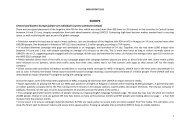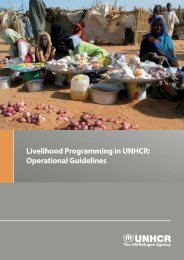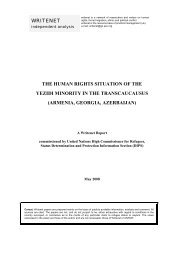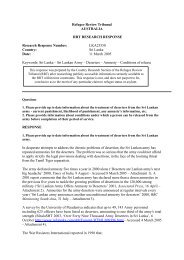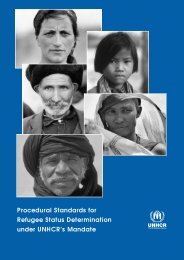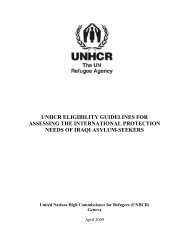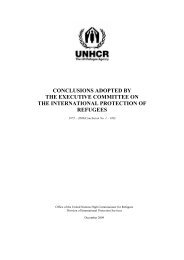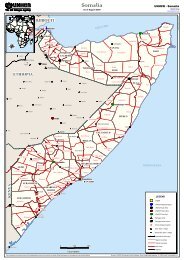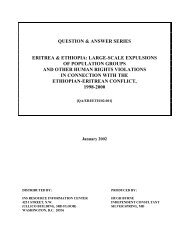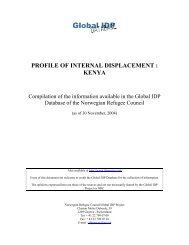UNHCR's ELIGIBILITY GUIDELINES FOR ASSESSING THE ...
UNHCR's ELIGIBILITY GUIDELINES FOR ASSESSING THE ...
UNHCR's ELIGIBILITY GUIDELINES FOR ASSESSING THE ...
You also want an ePaper? Increase the reach of your titles
YUMPU automatically turns print PDFs into web optimized ePapers that Google loves.
violence on a daily basis. Ordinary civilians are often the targets of violence, which<br />
includes car bombs, suicide attacks and improvised explosive devices. These methods of<br />
violence are usually targeted at chosen areas where civilians of specific religious or ethnic<br />
groups gather, including places of worship, market places and neighbourhoods. As clarified<br />
above, even where an individual may not have personally experienced threats or risks of<br />
harm, events surrounding his or her areas of residence or relating to others, may<br />
nonetheless give rise to a well-founded fear. There is also more specific targeting of<br />
individuals by extremist elements of one religious or political group against specific<br />
individuals of another, through kidnappings and execution-style killings. Rape is also<br />
increasingly being used as a means of persecution. Due to the vast number of actors who<br />
could perpetrate violence, an asylum-seeker’s failure to identify the perpetrator of violence<br />
should not be considered as detrimental to his/her credibility.<br />
Persecution is not limited, however, to acts which cause physical harm. Acts which restrict<br />
human rights can also amount to persecution, in particular, where the consequences are<br />
substantially prejudicial to the individual concerned. 728 Hence measures which restrict<br />
one’s ability to earn a living so that survival is threatened, would amount to persecution. 729<br />
Another type of restrictive measures is those which limit an individual’s fundamental right<br />
to freedom of religion, which could also amount to persecution. 730 This applies with regard<br />
to measures of a discriminatory nature which result in limitations on religious belief or<br />
practice, as well as forced conversion or forced compliance or conformity with religious<br />
practices, including, for example, certain clothing requirements or forms of behaviour. 731<br />
Consideration should be given to the nature of the restrictions, as well as their impact,<br />
including cumulative effect, on the individual concerned. It may be noted that throughout<br />
Iraq, discriminatory treatment by radical elements belonging to majority Muslim groups<br />
against moderate Muslims as well as against members of minority religious groups is<br />
increasingly taking on such serious proportions that it could be considered as amounting to<br />
persecution. In addition, non-Muslim as well as moderate Muslim women are coming<br />
under increasing pressure to abide by strict Islamic codes of behaviour which may be so<br />
restrictive as to be intolerable to the individuals concerned.<br />
In the three Northern Governorates, there is relatively greater religious and ethnic tolerance,<br />
and non-Muslims as well as members of non-Kurdish ethnic groups, are generally<br />
728 UNHCR, Handbook, para. 54, see above footnote 723.<br />
729 UNHCR, Handbook, para. 62-64, see above footnote 723.<br />
730 Article 18(3) of the ICCPR permits restrictions on the freedom to manifest one’s religion or beliefs if<br />
these restrictions “are prescribed by law and are necessary to protect public safety, order, health, or morals<br />
or the fundamental rights and freedoms of others.” Furthermore, such “limitations may be applied only for<br />
the purposes for which they were prescribed and must be directly related and proportionate to the specific<br />
need on which they are predicated. Restrictions may not be imposed for discriminatory purposes or applied in<br />
a discriminatory manner.” See Human Rights Committee, General Comment No. 22, adopted on 20 July<br />
1993, UN Doc. CCPR/C/21/Rev.1/Add.4, 27 September 1993, at paragraph 8, available in UNHCR’s<br />
Refworld at: http://www.unhcr.org/cgi-bin/texis/vtx/refworld/rwmain?docid=453883fb22.<br />
731 Further guidance on the assessment of claims to refugee status based on religion can be found in<br />
UNHCR’s Guidelines on International Protection: Religion-Based Refugee Claims under Article 1A(2) of the<br />
1951 Convention and/or the 1967 Protocol relating to the Status of Refugees, HCR/GIP/04/06, 28 April 2004,<br />
available in UNHCR’s Refworld at: http://www.unhcr.org/cgi-bin/texis/vtx/refworld/rwmain?docid=<br />
4090f9794.<br />
135




